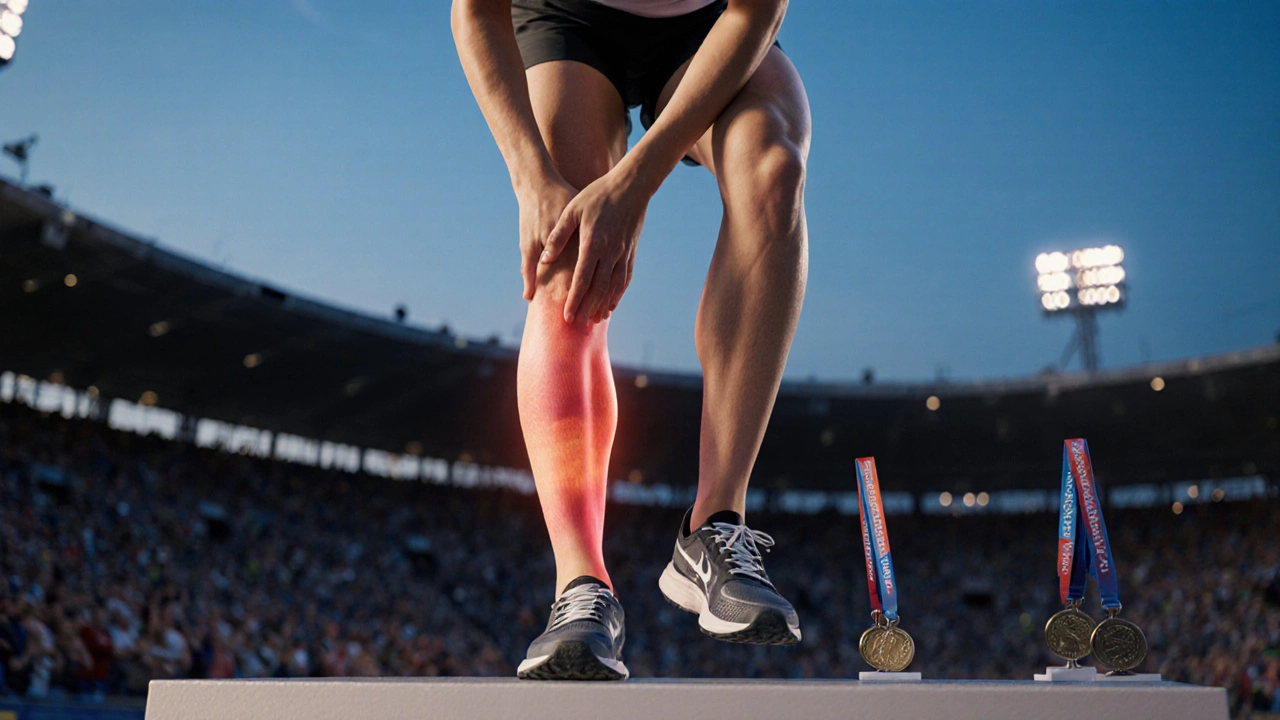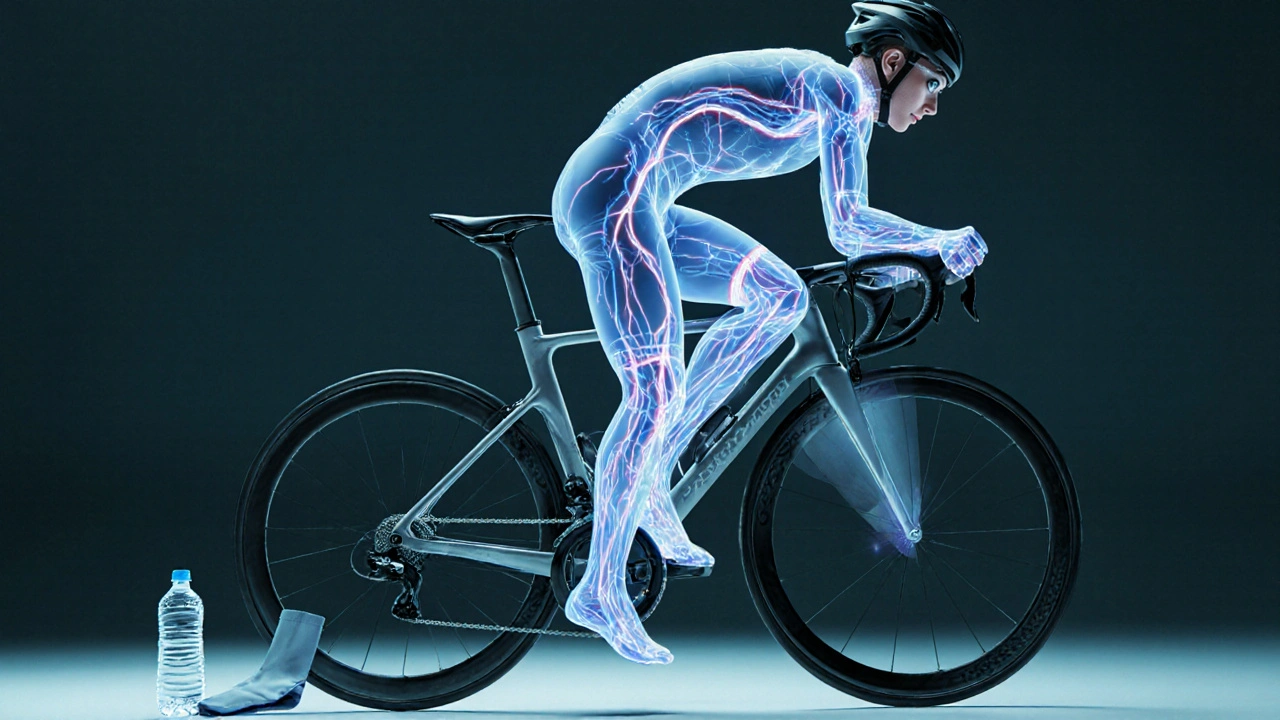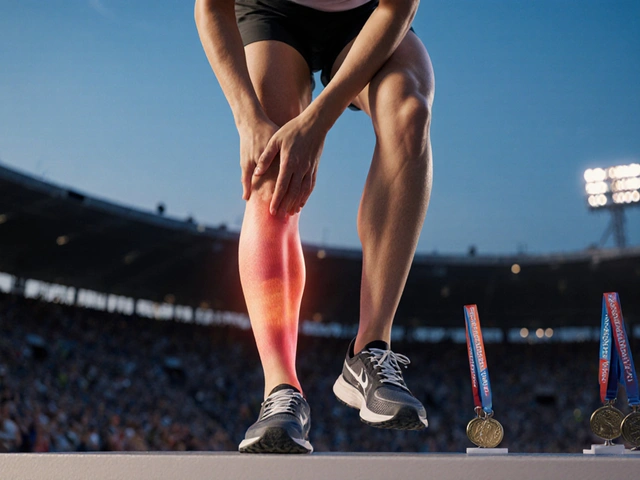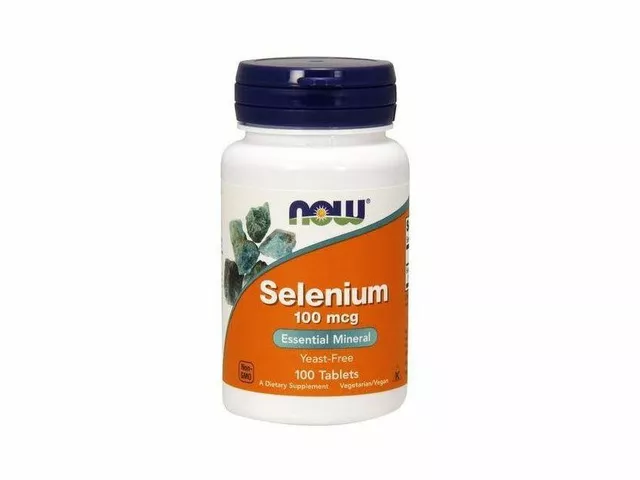Deep Vein Thrombosis in Athletes: Causes, Symptoms & Prevention Guide

Athlete DVT Risk Assessment Tool
Answer the following questions to assess your DVT risk:
Each "yes" adds 1 point to your risk score. A score of 2 or more indicates elevated risk.
When you picture a blood clot, the last thing that comes to mind is usually a marathon runner or a high‑intensity cyclist. Yet athletes can develop deep vein thrombosis (DVT) just as easily as anyone else-often because the very activities that keep them in peak shape also create perfect conditions for a clot to form.
Key Takeaways
- Intense training, dehydration, and prolonged immobility (think long flights after competitions) are major DVT triggers for athletes.
- Early signs include swelling, pain, and a warm feeling in the calf or thigh; don’t ignore them.
- Simple habits-staying hydrated, moving frequently, and using compression gear-cut risk dramatically.
- If you notice any symptoms, seek medical evaluation right away; an ultrasound can confirm a clot in minutes.
- Screening for inherited clotting disorders is advisable for athletes with a family history of thrombosis.
What Is Deep Vein Thrombosis?
Deep Vein Thrombosis is a condition where a blood clot (thrombus) forms in the deep veins, typically of the lower limbs. The clot can block blood flow, cause swelling, and, if it travels to the lungs, become a life‑threatening pulmonary embolism. In the general population, DVT accounts for roughly 900,000 cases each year in the U.S., but athletes represent a hidden subset whose risk factors differ from sedentary individuals.
Why Athletes Aren’t Immune
People assume that because athletes are fit, their circulatory system is bullet‑proof. In reality, several sport‑specific factors raise the odds of a clot:
- Athletes often undergo prolonged periods of immobility-think long-haul flights after an international meet or a 3‑hour recovery session where they remain seated.
- High‑intensity training can cause micro‑injuries to the vein walls, triggering inflammation and clot formation.
- Dehydration concentrates blood, increasing viscosity and the chance that platelets clump together.
- Some sports (e.g., cycling, rowing) involve a flexed hip position that compresses venous flow for hours.
- Use of performance‑enhancing substances, such as anabolic steroids, can raise clotting factors in the blood.
All these elements fall under the broader category of Venous Thromboembolism risk factors, the umbrella term for DVT and pulmonary embolism.

Spotting the Warning Signs
When a clot forms, the body sends clear signals:
- Sudden swelling in one leg, often the calf or thigh.
- A dull, throbbing ache that worsens when standing or walking.
- A feeling of warmth or heat over the affected area.
- Redness or a bluish tint to the skin.
If any of these appear after a race, a training camp, or a long travel day, treat them like a sprain-stop the activity and get checked out.
How to Lower Your Risk
Prevention isn’t about stopping training; it’s about tweaking habits so blood keeps flowing smoothly.
1. Stay Hydrated
Aim for at least 2.5L of fluid per day, more on hot training days. Electrolyte‑rich drinks help maintain plasma volume and reduce blood thickness.
2. Move Frequently During Long Periods of Inactivity
For flights longer than two hours, set a timer to stand up and walk the aisle every 30minutes. In the locker room, do ankle pumps and calf raises while waiting for equipment.
3. Use Compression Gear
Compression Stockings apply graduated pressure, encouraging venous return from the legs. Look for a 15‑30mmHg rating for athletic use; they’re snug but don’t cut off circulation.
4. Manage Training Load
Periodize your schedule-alternate high‑intensity blocks with lighter recovery weeks. This reduces chronic inflammation that can weaken vein walls.
5. Screen for Inherited Thrombophilia
If you have a family history of DVT, ask your doctor about genetic testing for Factor V Leiden, Prothrombin G20210A, or protein C/S deficiencies. Knowing your risk lets you take targeted steps, like prophylactic anticoagulation before long trips.
Quick Assessment Checklist
- Did you experience prolonged immobility (flight, car ride) in the past 48hours?
- Are you dehydrated or have you sweated heavily without replenishing fluids?
- Do you notice swelling, pain, or warmth in one leg?
- Do you have a personal or family history of clotting disorders?
If you answer “yes” to two or more, consider a medical review before your next competition.

When to Seek Medical Care
The most reliable diagnostic tool for DVT is a duplex Ultrasound. It visualizes clot location and estimates how much it blocks flow. Blood tests, like the D‑dimer assay, can rule out a clot when negative but aren’t definitive on their own.
If a clot is confirmed, doctors may prescribe short‑term Anticoagulants (e.g., low‑molecular‑weight heparin, direct oral anticoagulants). Most athletes can resume training after a few weeks on medication, once the clot resolves and blood work is normal.
Prevention Methods Compared
| Strategy | How It Works | Typical Reduction in Risk | Practical Tips |
|---|---|---|---|
| Hydration | Maintains plasma volume, lowers blood viscosity | ~30% reduction | Drink 500ml water every 1‑2hours during training |
| Compression Stockings | Graduated pressure improves venous return | ~25% reduction | Wear 15‑30mmHg stockings on travel days and post‑game |
| Frequent Movement | Prevents stasis by activating calf muscle pump | ~20% reduction | Stand/walk 5minutes every 30minutes on long trips |
| Training Load Management | Limits chronic inflammation and endothelial damage | ~15% reduction | Incorporate recovery weeks every 4‑6weeks |
| Medical Screening | Identifies inherited clotting disorders | Varies; can prevent 40% of recurrent events | Discuss family history with a sports‑medicine physician |
Frequently Asked Questions
Can running cause DVT?
Running itself isn’t a direct cause, but long marathons followed by prolonged sitting (e.g., airplane travel) increase risk. Staying hydrated and moving during travel lowers that danger.
Are compression socks safe for everyone?
Most healthy athletes can use them, but people with severe peripheral artery disease should avoid high‑pressure stockings. A quick check with a clinician ensures the right compression level.
How long does an athlete need to be on anticoagulants after a DVT?
Typical treatment lasts 3‑6months, but the exact duration depends on clot size, recurrence risk, and whether an underlying clotting disorder is present.
Is DVT more common in certain sports?
Yes. Endurance sports that involve prolonged static positions-like long‑distance cycling, rowing, and cross‑country skiing-show higher DVT incidence compared with intermittent‑movement sports such as soccer or basketball.
What is the Wells score and should athletes use it?
The Wells score is a clinical tool that estimates the probability of DVT based on symptoms and risk factors. While it’s designed for doctors, athletes can use it as a conversation starter with healthcare providers when they have concerning leg symptoms.








Hydration isn’t just for the day after a marathon; think of it as the oil that keeps the engine of your veins from seizing up. A couple of liters a day keeps blood from turning into syrup, which is exactly what DVT loves. So, yes, drink water like it’s your job.
When you consider the biomechanics of a cyclist’s hip flexion, you realize that the vascular system is subjected to a quasi‑static compression that, over hours, can be likened to a traffic jam in a bustling metropolis. In the grand tapestry of human physiology, the endothelium is the delicate parchment upon which the narrative of clot formation is inscribed, and micro‑injuries act as mischievous inkblots. Dehydration, then, is not merely a loss of water but a concentration of plasma proteins, raising the viscosity to a point where platelets become overly sociable, forming bonds they’d normally keep to a polite distance. The paradox is that athletes, who are celebrated for their cardiovascular prowess, can become victims of the very system they train so diligently. Long‑haul flights after a competition are the perfect storm: prolonged immobility, a dry cabin environment, and the emotional high of having just performed, which may lead to neglecting basic self‑care. Interestingly, the same adrenaline that fuels a sprint can also trigger cortisol release, which in turn modulates coagulation pathways. You could argue that the modern athlete is a walking contradiction, simultaneously seeking performance elevation while navigating hidden physiological minefields. The solution, of course, is not to abandon sport but to integrate preventive micro‑habits: scheduled calf pumps, compression garments calibrated to the appropriate millimetre‑mercury range, and a disciplined fluid intake schedule that respects both the sweat‑dry and the thirst‑wet states of the body. Moreover, genetic screening for Factor V Leiden or prothrombin mutations isn’t a luxury reserved for the medically elite; it’s an essential component of a comprehensive risk assessment for anyone whose career hinges on sustained vascular health. In essence, the path to a clot‑free training regimen is paved with awareness, incremental movement, and an unwavering commitment to hydration, not just for performance but for survival.
Yo, if you’re gonna push hard, remember to move those ankles every now and then-simple calf raises in the locker room can save a lot of trouble later.
It is imperative to observe that the linguistic precision of the term ‘compression stockings’ must be accompanied by correct usage of the pre‑positional phrase “for athletic use.” Furthermore, the recommendation to employ a graduated compression of 15‑30 mmHg is grounded in peer‑reviewed vascular studies. Kindly ensure that the duration of wear does not exceed 12 hours without a break to avoid iatrogenic complications.
Look, if you skip the water, you’re just asking for trouble-no need to be a hero, just drink.
Okay, listen up: the body isn’t a magical endless reservoir. When you sweat buckets and ignore the thirst, you’re practically inviting blood to thicken like caramel. That’s a recipe for clots, especially in the deep veins that love to hide in the calf. So, on those brutal training days, sip electrolytes constantly-don’t wait until you’re feeling like a desert.
Totally feel you on the dehydration thing-once I missed a water break on a 15‑km bike ride and my leg felt weird for days. Adding a quick ankle pump every few minutes changed everything, honestly.
Seriously, if you’re going to travel after a meet, stand up and march for five minutes every half hour. It’s not rocket science.